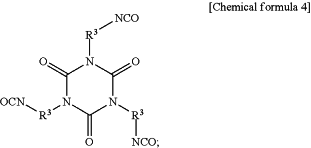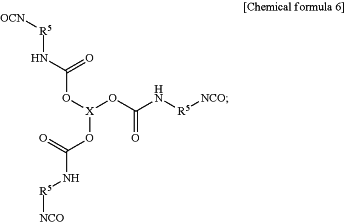| CPC C09J 175/08 (2013.01) [C08G 18/10 (2013.01); C08G 18/2081 (2013.01); C08G 18/5048 (2013.01); C08G 18/6208 (2013.01); C08G 18/778 (2013.01); C08G 18/7831 (2013.01); C08G 18/7837 (2013.01); C08G 18/794 (2013.01); C08G 2170/00 (2013.01); C09J 2203/354 (2020.08); C09J 2301/30 (2020.08); C09J 2423/106 (2013.01)] | 8 Claims |

|
1. A two-liquid type urethane-based adhesive comprises at least:
a main agent comprising:
(A) a urethane prepolymer having an isocyanate group at the end thereof;
(B) an alkoxysilyl group-containing polyfunctional isocyanate compound which is obtained through a reaction of a silane compound having two or more alkoxysilyl groups in one molecule and a polyisocyanate having an isocyanate group at the end thereof, wherein the silane compound having two or more alkoxysilyl groups in one molecule is a bissilylamine compound represented by the following chemical formula 1:
 where: each of six R1s is independently an alkyl group having 1 to 3 carbon atoms; and
each of two R2s is independently an alkylene group having 1 to 10 carbon atoms, and
wherein the polyisocyanate is a polyfunctional isocyanate compound selected from a group consisting of:
an isocyanurate-type polyfunctional isocyanate being a cyclic trimer of a diisocyanate, wherein the polyisocyanate is represented by the following chemical formula 4:
 where: each of three R3s is independently a linear or cyclic alkylene group which may be substituted with an alkyl group, an alkoxysilyl group, an acyl group, an alkoxycarbonyl group or a carboxyl group; or an organic group having a phenylene group which may be substituted with an alkyl group, an alkoxysilyl group, an acyl group, an akoxycarbonyl group or a carboxyl group;
a biuret-type polyfunctional isocyanate being an adduct of a diisocyanate to a urea group formed of a diisocyanate and an amine, wherein the polyisocyanate is represented by the following chemical formula 5:
 where: each of three R4s is independently a linear or cyclic alkylene group which may be substituted with an alkyl group, an alkoxysilyl group, an acyl group, an alkoxycarbonyl group or a carboxyl group; or an organic group having a phenylene group which may be substituted with an alkyl group, an alkoxysilyl group, an acyl group, an alkoxycarbonyl group or a carboxyl group;
an adduct-type polyfunctional isocyanate being an adduct of a diisocyanate to a poly-hydric alcohol, wherein the polyisocyanate is represented by the following chemical formula 6:
 where: each of three R5s is independently a linear or cyclic alkylene group which may be substituted with an alkyl group, an alkoxysilyl group, an acyl group, an alkoxycarbonyl group or a carboxyl group; or an organic group having a phenylene group which may be substituted by any of an alkyl group, an alkoxysilyl group, an acyl group, an alkoxycarbonyl group or a carboxyl group, and X is a trivalent hydrocarbon group having 1 to 3 carbon atoms; and
an allophanate-type polyfunctional isocyanate being an adduct of a diisocyanate to a urethane group formed of a diisocyanate and an alcohol, wherein the polyisocyanate is represented by the following chemical formula 7:
 where: each of two R6s is independently a linear or cyclic alkylene group which may be substituted with an alkyl group, an alkoxysilyl group, an acyl group, an alkoxycarbonyl group or a carboxyl group; or an organic group having a phenylene group which may be substituted by any of an alkyl group, an alkoxysilyl group, an acyl group, an alkoxycarbonyl group or a carboxyl group, and Y is an alkyl group having 1 to 3 carbon atoms; and
(C1) a first curing catalyst, and
a curing product comprising
(D) a hydrophobic polyol and a polyoxyalkylene polyol, and
(C2) a second curing catalyst.
|